SBM4305 - Information System Project Management Report: Analysis
VerifiedAdded on 2023/06/13
|14
|3137
|103
Report
AI Summary
This report provides an analysis of information system project management, covering key techniques, tools, processes, and knowledge areas essential for successful IT project management. It identifies and discusses various threats to IS project quality, including issues related to use cases, robustness, performance, localization, data quality, usability, and reliability. The report also explores the impacts of legal problems and cultural differences on information system project management, emphasizing the importance of addressing these factors for project success. Furthermore, it examines project closing processes, outputs, and utility, highlighting the steps involved in formally closing a project, the resources and services resulting from the project, and the benefits gained from its implementation. The study concludes by underscoring the significance of project management as a central competency for organizations to remain competitive and achieve desired business outcomes.
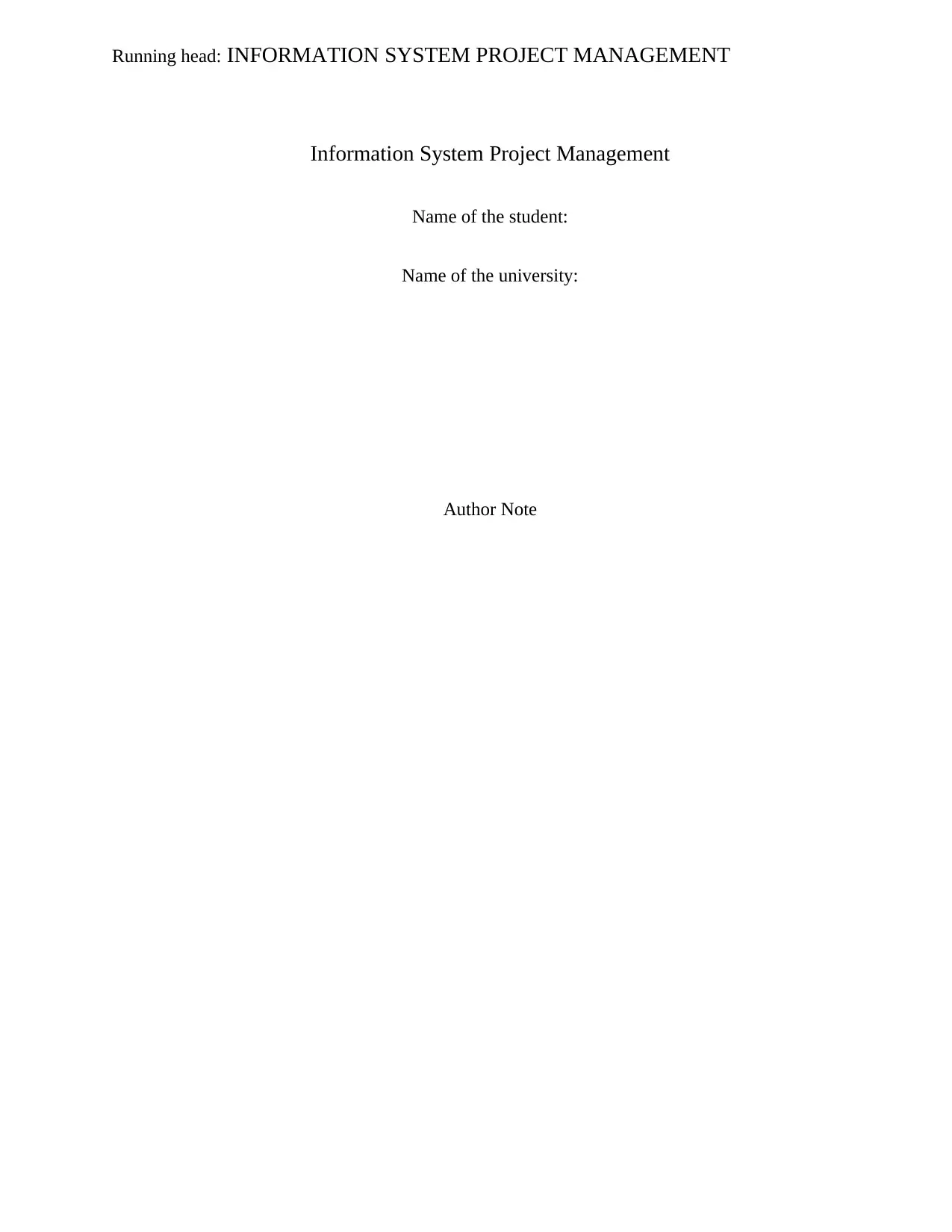
Running head: INFORMATION SYSTEM PROJECT MANAGEMENT
Information System Project Management
Name of the student:
Name of the university:
Author Note
Information System Project Management
Name of the student:
Name of the university:
Author Note
Paraphrase This Document
Need a fresh take? Get an instant paraphrase of this document with our AI Paraphraser
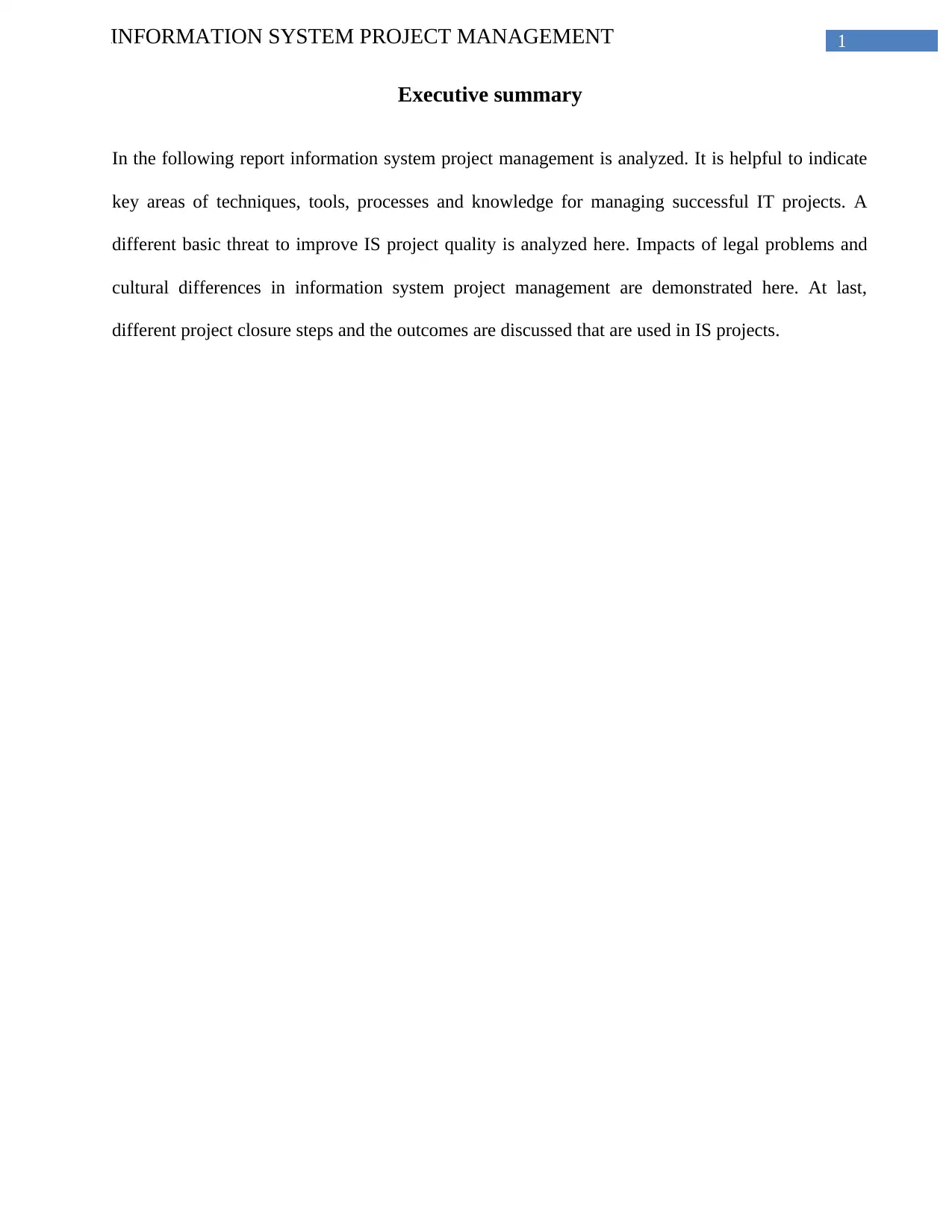
1INFORMATION SYSTEM PROJECT MANAGEMENT
Executive summary
In the following report information system project management is analyzed. It is helpful to indicate
key areas of techniques, tools, processes and knowledge for managing successful IT projects. A
different basic threat to improve IS project quality is analyzed here. Impacts of legal problems and
cultural differences in information system project management are demonstrated here. At last,
different project closure steps and the outcomes are discussed that are used in IS projects.
Executive summary
In the following report information system project management is analyzed. It is helpful to indicate
key areas of techniques, tools, processes and knowledge for managing successful IT projects. A
different basic threat to improve IS project quality is analyzed here. Impacts of legal problems and
cultural differences in information system project management are demonstrated here. At last,
different project closure steps and the outcomes are discussed that are used in IS projects.
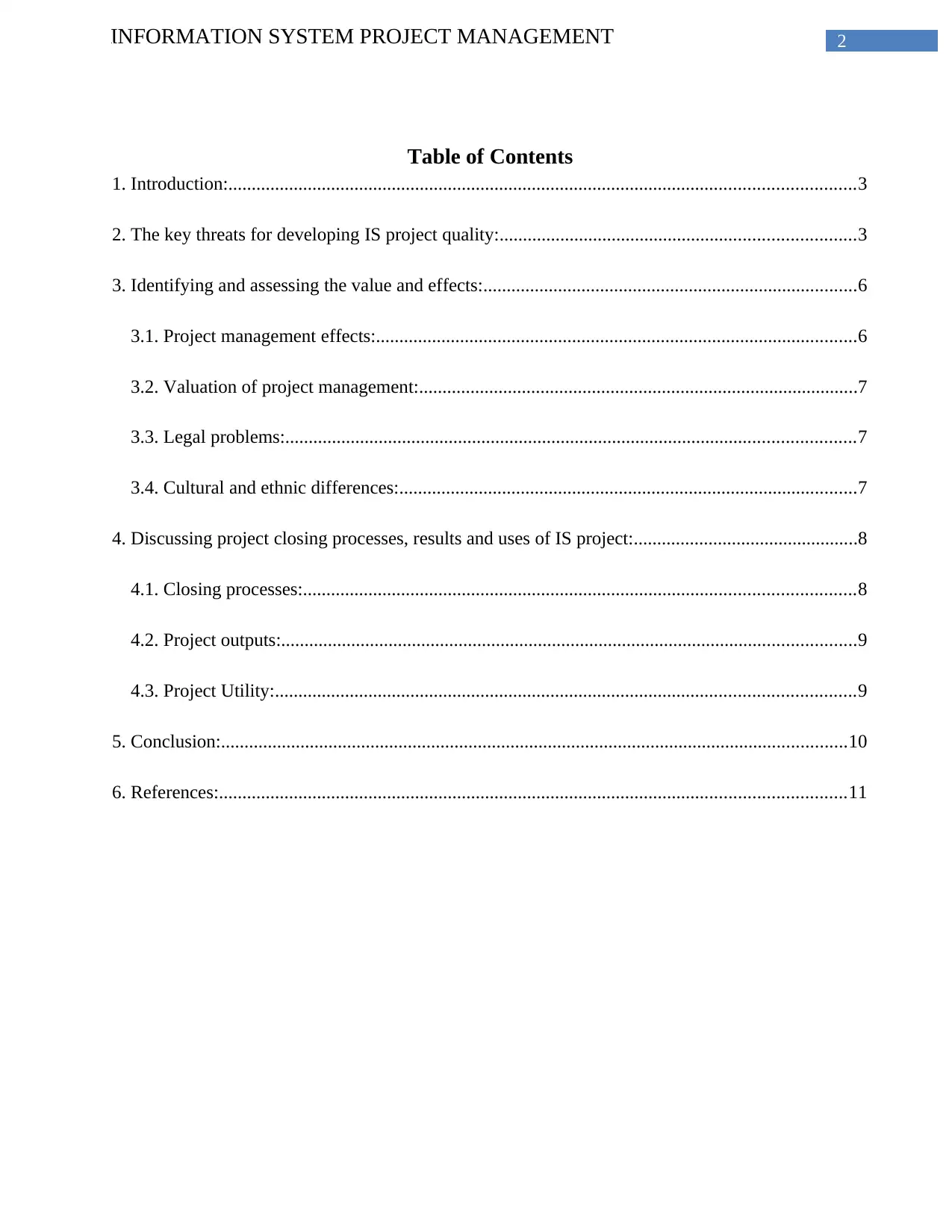
2INFORMATION SYSTEM PROJECT MANAGEMENT
Table of Contents
1. Introduction:......................................................................................................................................3
2. The key threats for developing IS project quality:............................................................................3
3. Identifying and assessing the value and effects:................................................................................6
3.1. Project management effects:.......................................................................................................6
3.2. Valuation of project management:..............................................................................................7
3.3. Legal problems:..........................................................................................................................7
3.4. Cultural and ethnic differences:..................................................................................................7
4. Discussing project closing processes, results and uses of IS project:................................................8
4.1. Closing processes:......................................................................................................................8
4.2. Project outputs:...........................................................................................................................9
4.3. Project Utility:............................................................................................................................9
5. Conclusion:......................................................................................................................................10
6. References:......................................................................................................................................11
Table of Contents
1. Introduction:......................................................................................................................................3
2. The key threats for developing IS project quality:............................................................................3
3. Identifying and assessing the value and effects:................................................................................6
3.1. Project management effects:.......................................................................................................6
3.2. Valuation of project management:..............................................................................................7
3.3. Legal problems:..........................................................................................................................7
3.4. Cultural and ethnic differences:..................................................................................................7
4. Discussing project closing processes, results and uses of IS project:................................................8
4.1. Closing processes:......................................................................................................................8
4.2. Project outputs:...........................................................................................................................9
4.3. Project Utility:............................................................................................................................9
5. Conclusion:......................................................................................................................................10
6. References:......................................................................................................................................11
⊘ This is a preview!⊘
Do you want full access?
Subscribe today to unlock all pages.

Trusted by 1+ million students worldwide
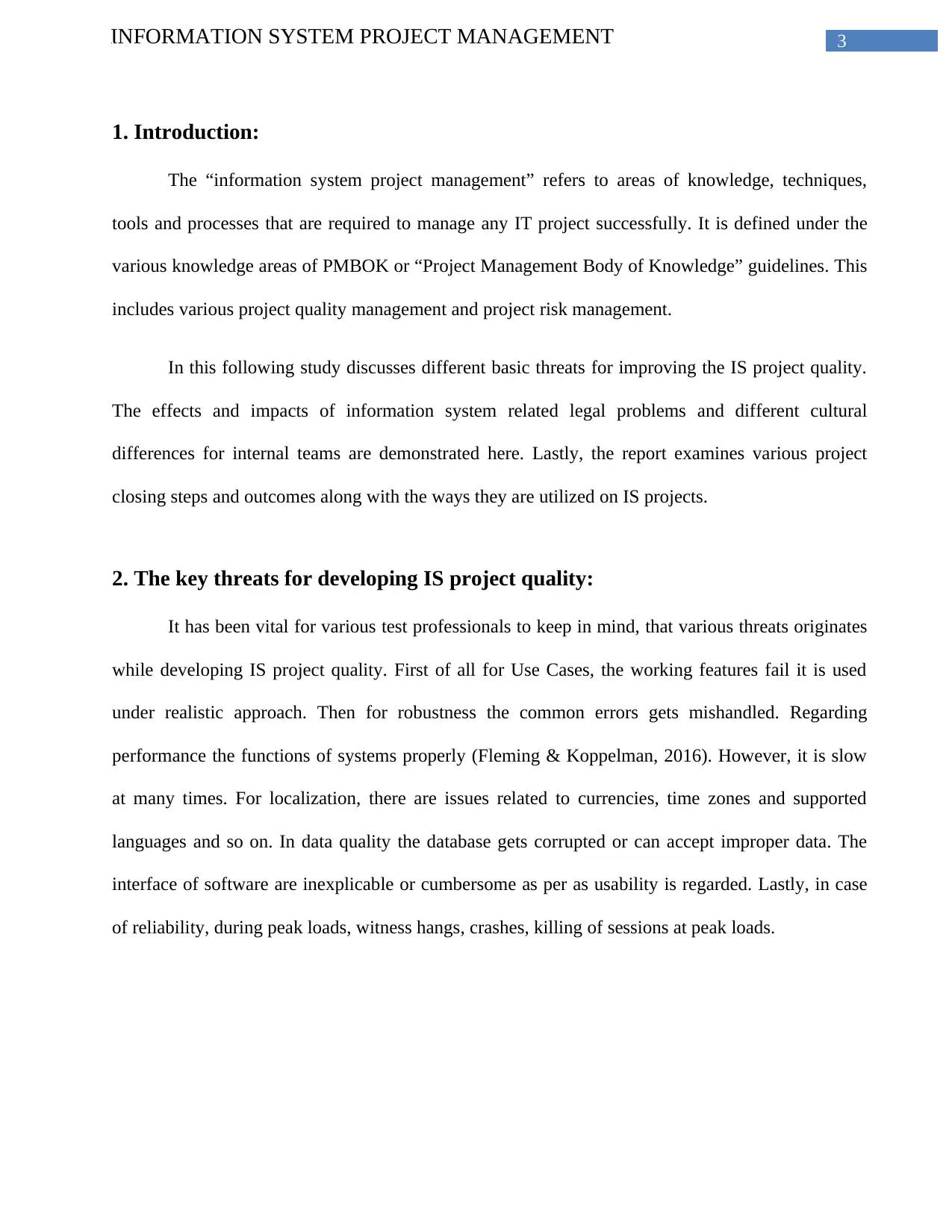
3INFORMATION SYSTEM PROJECT MANAGEMENT
1. Introduction:
The “information system project management” refers to areas of knowledge, techniques,
tools and processes that are required to manage any IT project successfully. It is defined under the
various knowledge areas of PMBOK or “Project Management Body of Knowledge” guidelines. This
includes various project quality management and project risk management.
In this following study discusses different basic threats for improving the IS project quality.
The effects and impacts of information system related legal problems and different cultural
differences for internal teams are demonstrated here. Lastly, the report examines various project
closing steps and outcomes along with the ways they are utilized on IS projects.
2. The key threats for developing IS project quality:
It has been vital for various test professionals to keep in mind, that various threats originates
while developing IS project quality. First of all for Use Cases, the working features fail it is used
under realistic approach. Then for robustness the common errors gets mishandled. Regarding
performance the functions of systems properly (Fleming & Koppelman, 2016). However, it is slow
at many times. For localization, there are issues related to currencies, time zones and supported
languages and so on. In data quality the database gets corrupted or can accept improper data. The
interface of software are inexplicable or cumbersome as per as usability is regarded. Lastly, in case
of reliability, during peak loads, witness hangs, crashes, killing of sessions at peak loads.
1. Introduction:
The “information system project management” refers to areas of knowledge, techniques,
tools and processes that are required to manage any IT project successfully. It is defined under the
various knowledge areas of PMBOK or “Project Management Body of Knowledge” guidelines. This
includes various project quality management and project risk management.
In this following study discusses different basic threats for improving the IS project quality.
The effects and impacts of information system related legal problems and different cultural
differences for internal teams are demonstrated here. Lastly, the report examines various project
closing steps and outcomes along with the ways they are utilized on IS projects.
2. The key threats for developing IS project quality:
It has been vital for various test professionals to keep in mind, that various threats originates
while developing IS project quality. First of all for Use Cases, the working features fail it is used
under realistic approach. Then for robustness the common errors gets mishandled. Regarding
performance the functions of systems properly (Fleming & Koppelman, 2016). However, it is slow
at many times. For localization, there are issues related to currencies, time zones and supported
languages and so on. In data quality the database gets corrupted or can accept improper data. The
interface of software are inexplicable or cumbersome as per as usability is regarded. Lastly, in case
of reliability, during peak loads, witness hangs, crashes, killing of sessions at peak loads.
Paraphrase This Document
Need a fresh take? Get an instant paraphrase of this document with our AI Paraphraser
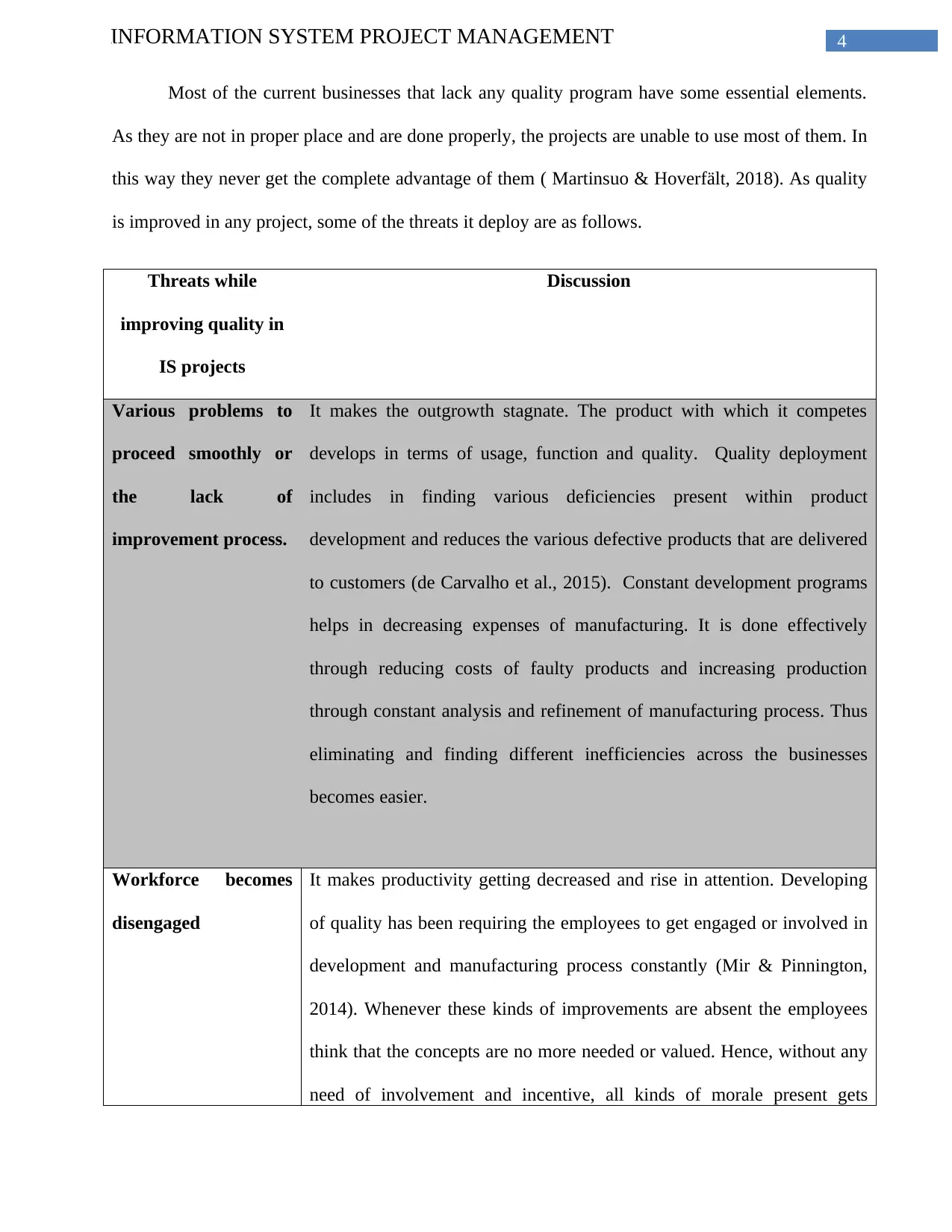
4INFORMATION SYSTEM PROJECT MANAGEMENT
Most of the current businesses that lack any quality program have some essential elements.
As they are not in proper place and are done properly, the projects are unable to use most of them. In
this way they never get the complete advantage of them ( Martinsuo & Hoverfält, 2018). As quality
is improved in any project, some of the threats it deploy are as follows.
Threats while
improving quality in
IS projects
Discussion
Various problems to
proceed smoothly or
the lack of
improvement process.
It makes the outgrowth stagnate. The product with which it competes
develops in terms of usage, function and quality. Quality deployment
includes in finding various deficiencies present within product
development and reduces the various defective products that are delivered
to customers (de Carvalho et al., 2015). Constant development programs
helps in decreasing expenses of manufacturing. It is done effectively
through reducing costs of faulty products and increasing production
through constant analysis and refinement of manufacturing process. Thus
eliminating and finding different inefficiencies across the businesses
becomes easier.
Workforce becomes
disengaged
It makes productivity getting decreased and rise in attention. Developing
of quality has been requiring the employees to get engaged or involved in
development and manufacturing process constantly (Mir & Pinnington,
2014). Whenever these kinds of improvements are absent the employees
think that the concepts are no more needed or valued. Hence, without any
need of involvement and incentive, all kinds of morale present gets
Most of the current businesses that lack any quality program have some essential elements.
As they are not in proper place and are done properly, the projects are unable to use most of them. In
this way they never get the complete advantage of them ( Martinsuo & Hoverfält, 2018). As quality
is improved in any project, some of the threats it deploy are as follows.
Threats while
improving quality in
IS projects
Discussion
Various problems to
proceed smoothly or
the lack of
improvement process.
It makes the outgrowth stagnate. The product with which it competes
develops in terms of usage, function and quality. Quality deployment
includes in finding various deficiencies present within product
development and reduces the various defective products that are delivered
to customers (de Carvalho et al., 2015). Constant development programs
helps in decreasing expenses of manufacturing. It is done effectively
through reducing costs of faulty products and increasing production
through constant analysis and refinement of manufacturing process. Thus
eliminating and finding different inefficiencies across the businesses
becomes easier.
Workforce becomes
disengaged
It makes productivity getting decreased and rise in attention. Developing
of quality has been requiring the employees to get engaged or involved in
development and manufacturing process constantly (Mir & Pinnington,
2014). Whenever these kinds of improvements are absent the employees
think that the concepts are no more needed or valued. Hence, without any
need of involvement and incentive, all kinds of morale present gets
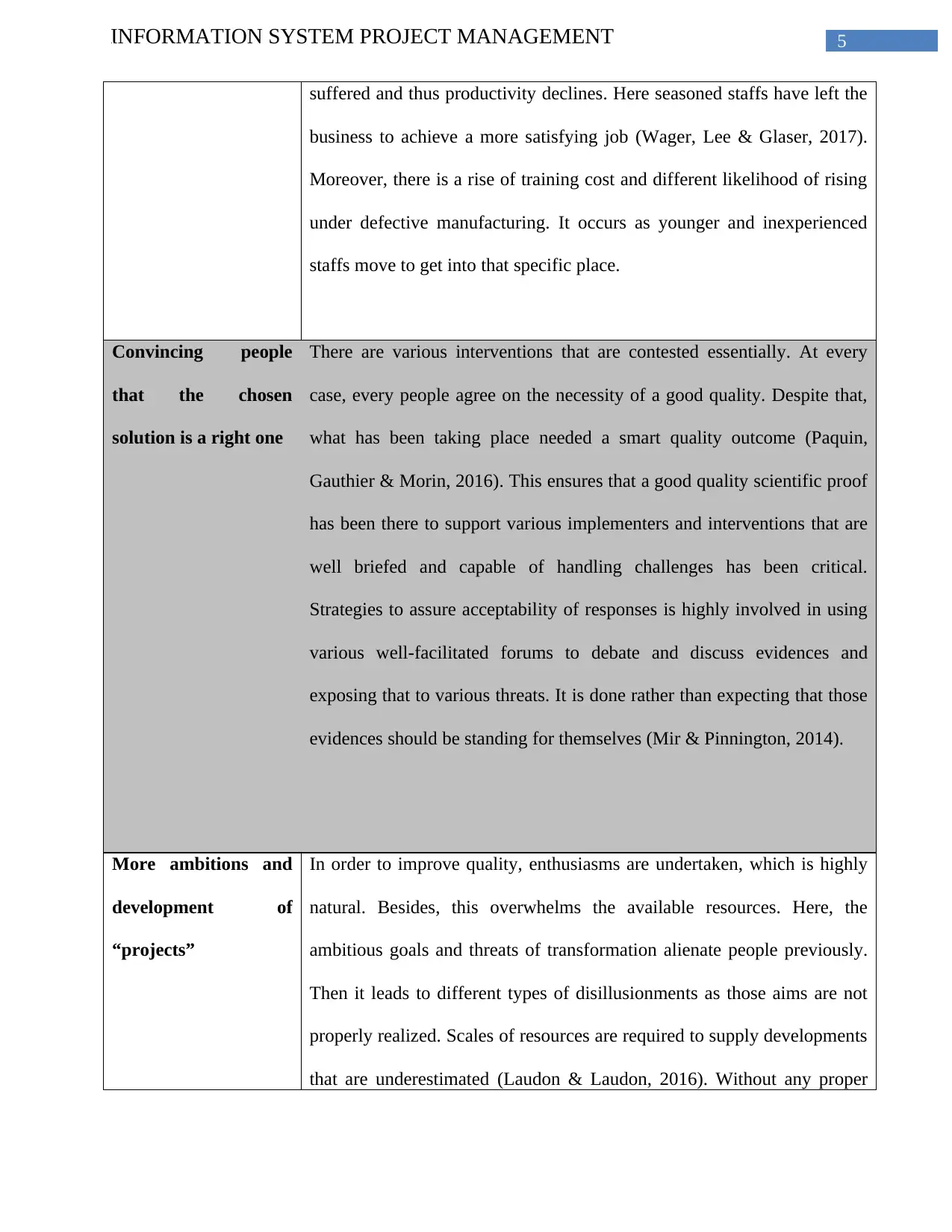
5INFORMATION SYSTEM PROJECT MANAGEMENT
suffered and thus productivity declines. Here seasoned staffs have left the
business to achieve a more satisfying job (Wager, Lee & Glaser, 2017).
Moreover, there is a rise of training cost and different likelihood of rising
under defective manufacturing. It occurs as younger and inexperienced
staffs move to get into that specific place.
Convincing people
that the chosen
solution is a right one
There are various interventions that are contested essentially. At every
case, every people agree on the necessity of a good quality. Despite that,
what has been taking place needed a smart quality outcome (Paquin,
Gauthier & Morin, 2016). This ensures that a good quality scientific proof
has been there to support various implementers and interventions that are
well briefed and capable of handling challenges has been critical.
Strategies to assure acceptability of responses is highly involved in using
various well-facilitated forums to debate and discuss evidences and
exposing that to various threats. It is done rather than expecting that those
evidences should be standing for themselves (Mir & Pinnington, 2014).
More ambitions and
development of
“projects”
In order to improve quality, enthusiasms are undertaken, which is highly
natural. Besides, this overwhelms the available resources. Here, the
ambitious goals and threats of transformation alienate people previously.
Then it leads to different types of disillusionments as those aims are not
properly realized. Scales of resources are required to supply developments
that are underestimated (Laudon & Laudon, 2016). Without any proper
suffered and thus productivity declines. Here seasoned staffs have left the
business to achieve a more satisfying job (Wager, Lee & Glaser, 2017).
Moreover, there is a rise of training cost and different likelihood of rising
under defective manufacturing. It occurs as younger and inexperienced
staffs move to get into that specific place.
Convincing people
that the chosen
solution is a right one
There are various interventions that are contested essentially. At every
case, every people agree on the necessity of a good quality. Despite that,
what has been taking place needed a smart quality outcome (Paquin,
Gauthier & Morin, 2016). This ensures that a good quality scientific proof
has been there to support various implementers and interventions that are
well briefed and capable of handling challenges has been critical.
Strategies to assure acceptability of responses is highly involved in using
various well-facilitated forums to debate and discuss evidences and
exposing that to various threats. It is done rather than expecting that those
evidences should be standing for themselves (Mir & Pinnington, 2014).
More ambitions and
development of
“projects”
In order to improve quality, enthusiasms are undertaken, which is highly
natural. Besides, this overwhelms the available resources. Here, the
ambitious goals and threats of transformation alienate people previously.
Then it leads to different types of disillusionments as those aims are not
properly realized. Scales of resources are required to supply developments
that are underestimated (Laudon & Laudon, 2016). Without any proper
⊘ This is a preview!⊘
Do you want full access?
Subscribe today to unlock all pages.

Trusted by 1+ million students worldwide
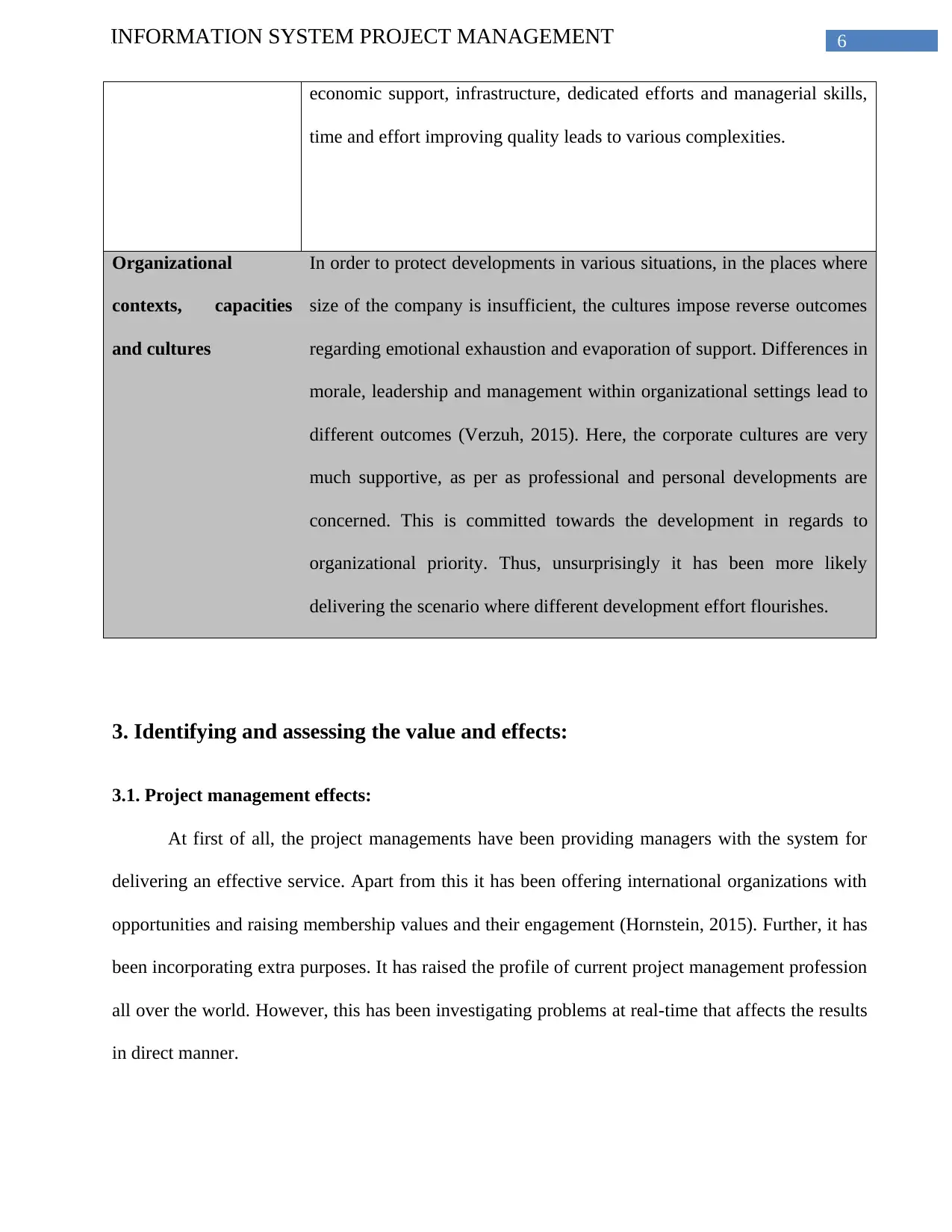
6INFORMATION SYSTEM PROJECT MANAGEMENT
economic support, infrastructure, dedicated efforts and managerial skills,
time and effort improving quality leads to various complexities.
Organizational
contexts, capacities
and cultures
In order to protect developments in various situations, in the places where
size of the company is insufficient, the cultures impose reverse outcomes
regarding emotional exhaustion and evaporation of support. Differences in
morale, leadership and management within organizational settings lead to
different outcomes (Verzuh, 2015). Here, the corporate cultures are very
much supportive, as per as professional and personal developments are
concerned. This is committed towards the development in regards to
organizational priority. Thus, unsurprisingly it has been more likely
delivering the scenario where different development effort flourishes.
3. Identifying and assessing the value and effects:
3.1. Project management effects:
At first of all, the project managements have been providing managers with the system for
delivering an effective service. Apart from this it has been offering international organizations with
opportunities and raising membership values and their engagement (Hornstein, 2015). Further, it has
been incorporating extra purposes. It has raised the profile of current project management profession
all over the world. However, this has been investigating problems at real-time that affects the results
in direct manner.
economic support, infrastructure, dedicated efforts and managerial skills,
time and effort improving quality leads to various complexities.
Organizational
contexts, capacities
and cultures
In order to protect developments in various situations, in the places where
size of the company is insufficient, the cultures impose reverse outcomes
regarding emotional exhaustion and evaporation of support. Differences in
morale, leadership and management within organizational settings lead to
different outcomes (Verzuh, 2015). Here, the corporate cultures are very
much supportive, as per as professional and personal developments are
concerned. This is committed towards the development in regards to
organizational priority. Thus, unsurprisingly it has been more likely
delivering the scenario where different development effort flourishes.
3. Identifying and assessing the value and effects:
3.1. Project management effects:
At first of all, the project managements have been providing managers with the system for
delivering an effective service. Apart from this it has been offering international organizations with
opportunities and raising membership values and their engagement (Hornstein, 2015). Further, it has
been incorporating extra purposes. It has raised the profile of current project management profession
all over the world. However, this has been investigating problems at real-time that affects the results
in direct manner.
Paraphrase This Document
Need a fresh take? Get an instant paraphrase of this document with our AI Paraphraser
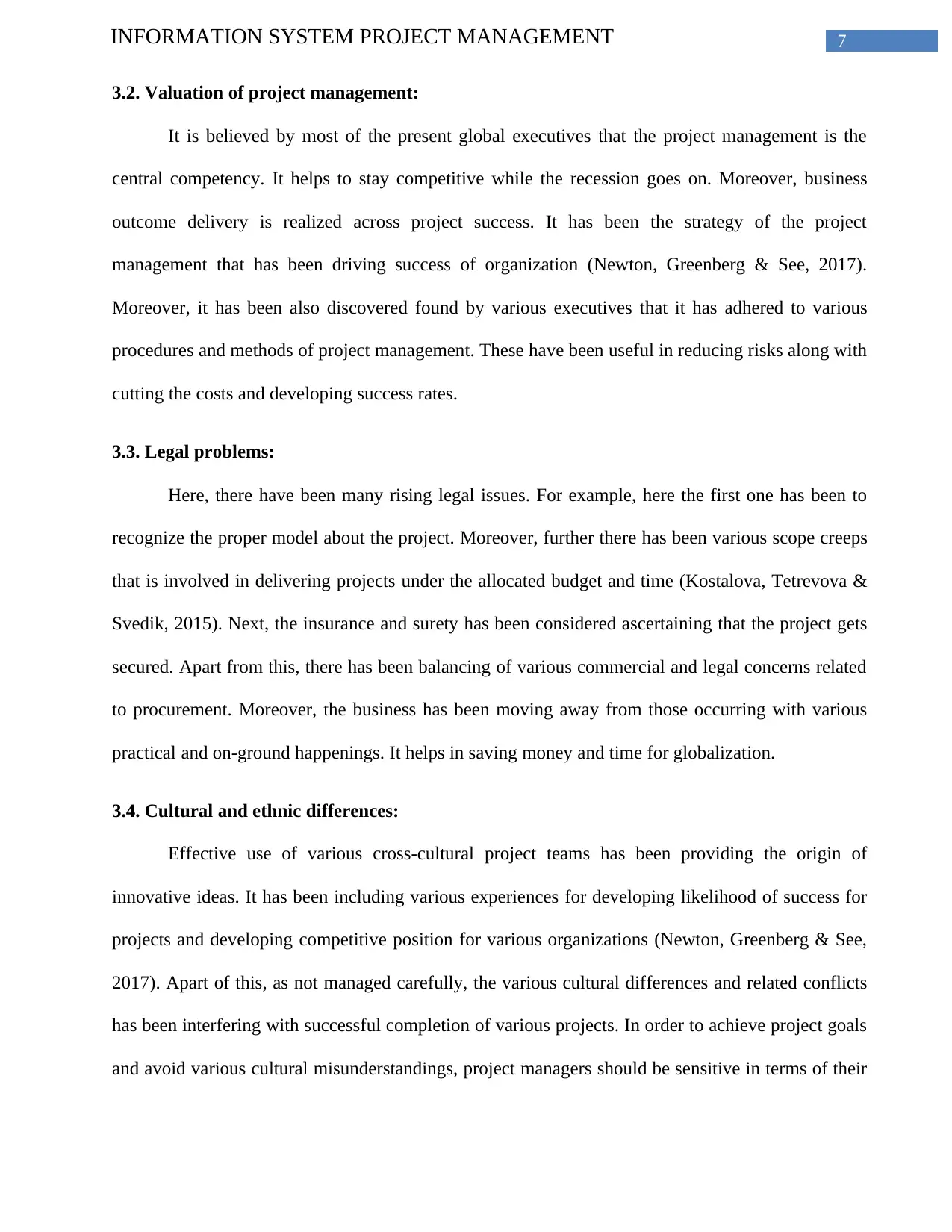
7INFORMATION SYSTEM PROJECT MANAGEMENT
3.2. Valuation of project management:
It is believed by most of the present global executives that the project management is the
central competency. It helps to stay competitive while the recession goes on. Moreover, business
outcome delivery is realized across project success. It has been the strategy of the project
management that has been driving success of organization (Newton, Greenberg & See, 2017).
Moreover, it has been also discovered found by various executives that it has adhered to various
procedures and methods of project management. These have been useful in reducing risks along with
cutting the costs and developing success rates.
3.3. Legal problems:
Here, there have been many rising legal issues. For example, here the first one has been to
recognize the proper model about the project. Moreover, further there has been various scope creeps
that is involved in delivering projects under the allocated budget and time (Kostalova, Tetrevova &
Svedik, 2015). Next, the insurance and surety has been considered ascertaining that the project gets
secured. Apart from this, there has been balancing of various commercial and legal concerns related
to procurement. Moreover, the business has been moving away from those occurring with various
practical and on-ground happenings. It helps in saving money and time for globalization.
3.4. Cultural and ethnic differences:
Effective use of various cross-cultural project teams has been providing the origin of
innovative ideas. It has been including various experiences for developing likelihood of success for
projects and developing competitive position for various organizations (Newton, Greenberg & See,
2017). Apart of this, as not managed carefully, the various cultural differences and related conflicts
has been interfering with successful completion of various projects. In order to achieve project goals
and avoid various cultural misunderstandings, project managers should be sensitive in terms of their
3.2. Valuation of project management:
It is believed by most of the present global executives that the project management is the
central competency. It helps to stay competitive while the recession goes on. Moreover, business
outcome delivery is realized across project success. It has been the strategy of the project
management that has been driving success of organization (Newton, Greenberg & See, 2017).
Moreover, it has been also discovered found by various executives that it has adhered to various
procedures and methods of project management. These have been useful in reducing risks along with
cutting the costs and developing success rates.
3.3. Legal problems:
Here, there have been many rising legal issues. For example, here the first one has been to
recognize the proper model about the project. Moreover, further there has been various scope creeps
that is involved in delivering projects under the allocated budget and time (Kostalova, Tetrevova &
Svedik, 2015). Next, the insurance and surety has been considered ascertaining that the project gets
secured. Apart from this, there has been balancing of various commercial and legal concerns related
to procurement. Moreover, the business has been moving away from those occurring with various
practical and on-ground happenings. It helps in saving money and time for globalization.
3.4. Cultural and ethnic differences:
Effective use of various cross-cultural project teams has been providing the origin of
innovative ideas. It has been including various experiences for developing likelihood of success for
projects and developing competitive position for various organizations (Newton, Greenberg & See,
2017). Apart of this, as not managed carefully, the various cultural differences and related conflicts
has been interfering with successful completion of various projects. In order to achieve project goals
and avoid various cultural misunderstandings, project managers should be sensitive in terms of their
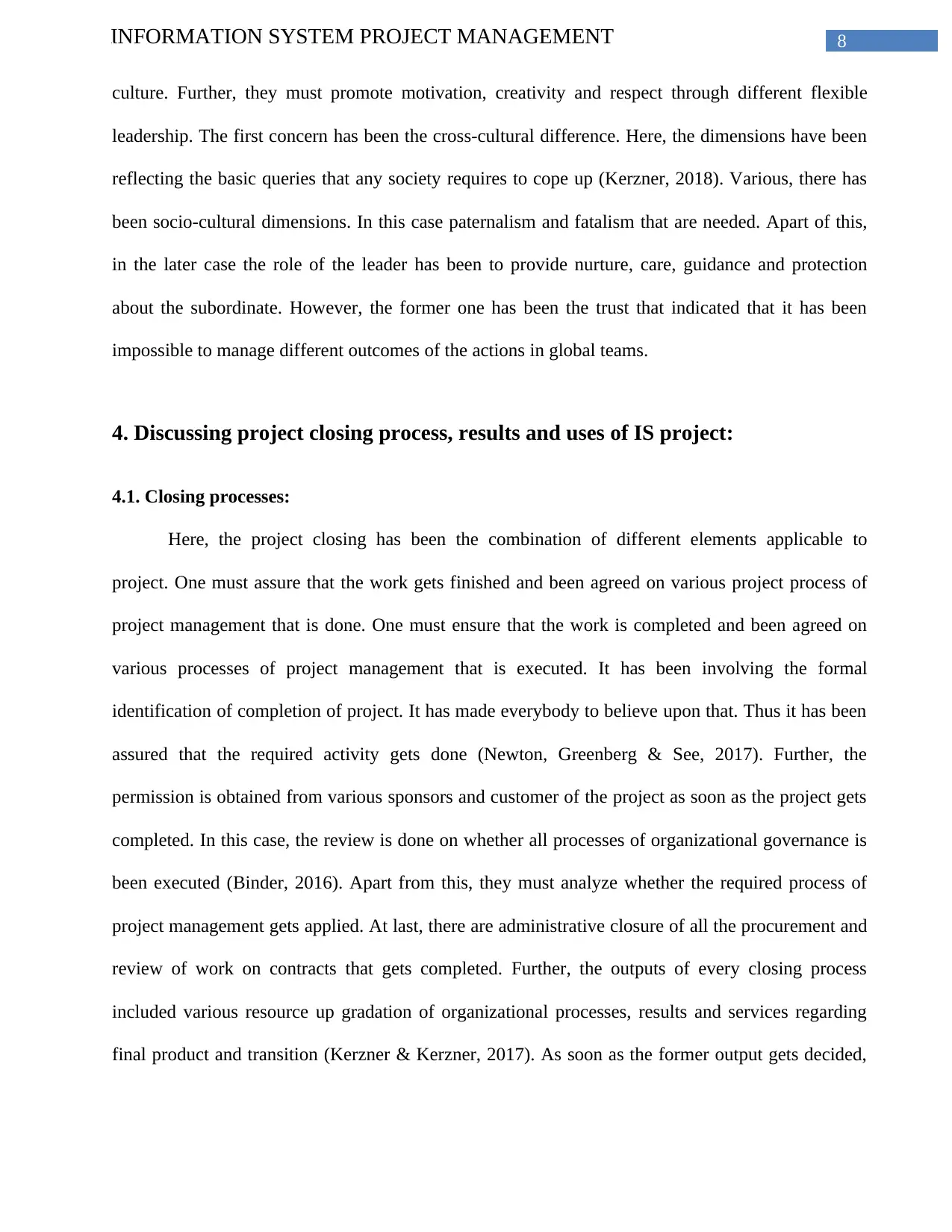
8INFORMATION SYSTEM PROJECT MANAGEMENT
culture. Further, they must promote motivation, creativity and respect through different flexible
leadership. The first concern has been the cross-cultural difference. Here, the dimensions have been
reflecting the basic queries that any society requires to cope up (Kerzner, 2018). Various, there has
been socio-cultural dimensions. In this case paternalism and fatalism that are needed. Apart of this,
in the later case the role of the leader has been to provide nurture, care, guidance and protection
about the subordinate. However, the former one has been the trust that indicated that it has been
impossible to manage different outcomes of the actions in global teams.
4. Discussing project closing process, results and uses of IS project:
4.1. Closing processes:
Here, the project closing has been the combination of different elements applicable to
project. One must assure that the work gets finished and been agreed on various project process of
project management that is done. One must ensure that the work is completed and been agreed on
various processes of project management that is executed. It has been involving the formal
identification of completion of project. It has made everybody to believe upon that. Thus it has been
assured that the required activity gets done (Newton, Greenberg & See, 2017). Further, the
permission is obtained from various sponsors and customer of the project as soon as the project gets
completed. In this case, the review is done on whether all processes of organizational governance is
been executed (Binder, 2016). Apart from this, they must analyze whether the required process of
project management gets applied. At last, there are administrative closure of all the procurement and
review of work on contracts that gets completed. Further, the outputs of every closing process
included various resource up gradation of organizational processes, results and services regarding
final product and transition (Kerzner & Kerzner, 2017). As soon as the former output gets decided,
culture. Further, they must promote motivation, creativity and respect through different flexible
leadership. The first concern has been the cross-cultural difference. Here, the dimensions have been
reflecting the basic queries that any society requires to cope up (Kerzner, 2018). Various, there has
been socio-cultural dimensions. In this case paternalism and fatalism that are needed. Apart of this,
in the later case the role of the leader has been to provide nurture, care, guidance and protection
about the subordinate. However, the former one has been the trust that indicated that it has been
impossible to manage different outcomes of the actions in global teams.
4. Discussing project closing process, results and uses of IS project:
4.1. Closing processes:
Here, the project closing has been the combination of different elements applicable to
project. One must assure that the work gets finished and been agreed on various project process of
project management that is done. One must ensure that the work is completed and been agreed on
various processes of project management that is executed. It has been involving the formal
identification of completion of project. It has made everybody to believe upon that. Thus it has been
assured that the required activity gets done (Newton, Greenberg & See, 2017). Further, the
permission is obtained from various sponsors and customer of the project as soon as the project gets
completed. In this case, the review is done on whether all processes of organizational governance is
been executed (Binder, 2016). Apart from this, they must analyze whether the required process of
project management gets applied. At last, there are administrative closure of all the procurement and
review of work on contracts that gets completed. Further, the outputs of every closing process
included various resource up gradation of organizational processes, results and services regarding
final product and transition (Kerzner & Kerzner, 2017). As soon as the former output gets decided,
⊘ This is a preview!⊘
Do you want full access?
Subscribe today to unlock all pages.

Trusted by 1+ million students worldwide
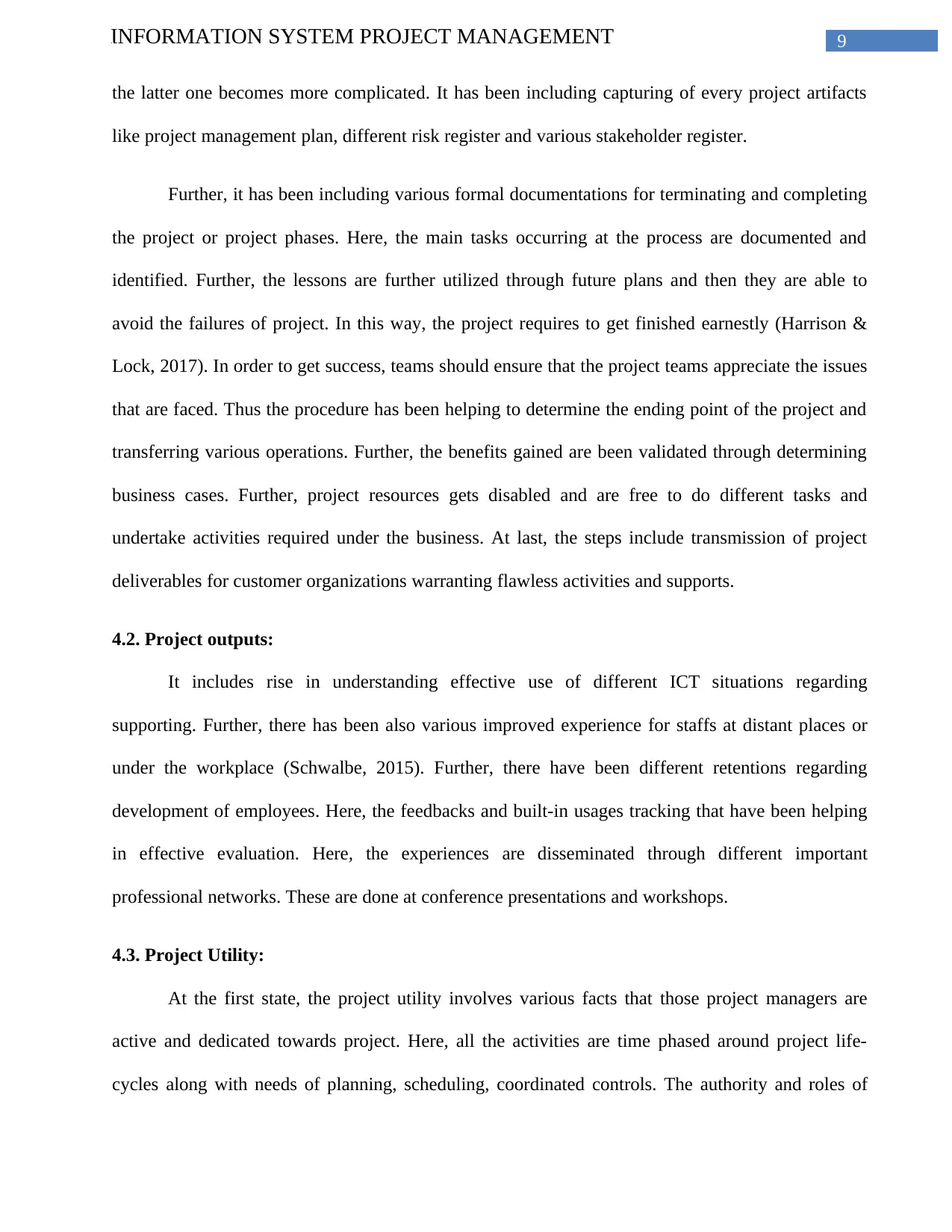
9INFORMATION SYSTEM PROJECT MANAGEMENT
the latter one becomes more complicated. It has been including capturing of every project artifacts
like project management plan, different risk register and various stakeholder register.
Further, it has been including various formal documentations for terminating and completing
the project or project phases. Here, the main tasks occurring at the process are documented and
identified. Further, the lessons are further utilized through future plans and then they are able to
avoid the failures of project. In this way, the project requires to get finished earnestly (Harrison &
Lock, 2017). In order to get success, teams should ensure that the project teams appreciate the issues
that are faced. Thus the procedure has been helping to determine the ending point of the project and
transferring various operations. Further, the benefits gained are been validated through determining
business cases. Further, project resources gets disabled and are free to do different tasks and
undertake activities required under the business. At last, the steps include transmission of project
deliverables for customer organizations warranting flawless activities and supports.
4.2. Project outputs:
It includes rise in understanding effective use of different ICT situations regarding
supporting. Further, there has been also various improved experience for staffs at distant places or
under the workplace (Schwalbe, 2015). Further, there have been different retentions regarding
development of employees. Here, the feedbacks and built-in usages tracking that have been helping
in effective evaluation. Here, the experiences are disseminated through different important
professional networks. These are done at conference presentations and workshops.
4.3. Project Utility:
At the first state, the project utility involves various facts that those project managers are
active and dedicated towards project. Here, all the activities are time phased around project life-
cycles along with needs of planning, scheduling, coordinated controls. The authority and roles of
the latter one becomes more complicated. It has been including capturing of every project artifacts
like project management plan, different risk register and various stakeholder register.
Further, it has been including various formal documentations for terminating and completing
the project or project phases. Here, the main tasks occurring at the process are documented and
identified. Further, the lessons are further utilized through future plans and then they are able to
avoid the failures of project. In this way, the project requires to get finished earnestly (Harrison &
Lock, 2017). In order to get success, teams should ensure that the project teams appreciate the issues
that are faced. Thus the procedure has been helping to determine the ending point of the project and
transferring various operations. Further, the benefits gained are been validated through determining
business cases. Further, project resources gets disabled and are free to do different tasks and
undertake activities required under the business. At last, the steps include transmission of project
deliverables for customer organizations warranting flawless activities and supports.
4.2. Project outputs:
It includes rise in understanding effective use of different ICT situations regarding
supporting. Further, there has been also various improved experience for staffs at distant places or
under the workplace (Schwalbe, 2015). Further, there have been different retentions regarding
development of employees. Here, the feedbacks and built-in usages tracking that have been helping
in effective evaluation. Here, the experiences are disseminated through different important
professional networks. These are done at conference presentations and workshops.
4.3. Project Utility:
At the first state, the project utility involves various facts that those project managers are
active and dedicated towards project. Here, all the activities are time phased around project life-
cycles along with needs of planning, scheduling, coordinated controls. The authority and roles of
Paraphrase This Document
Need a fresh take? Get an instant paraphrase of this document with our AI Paraphraser
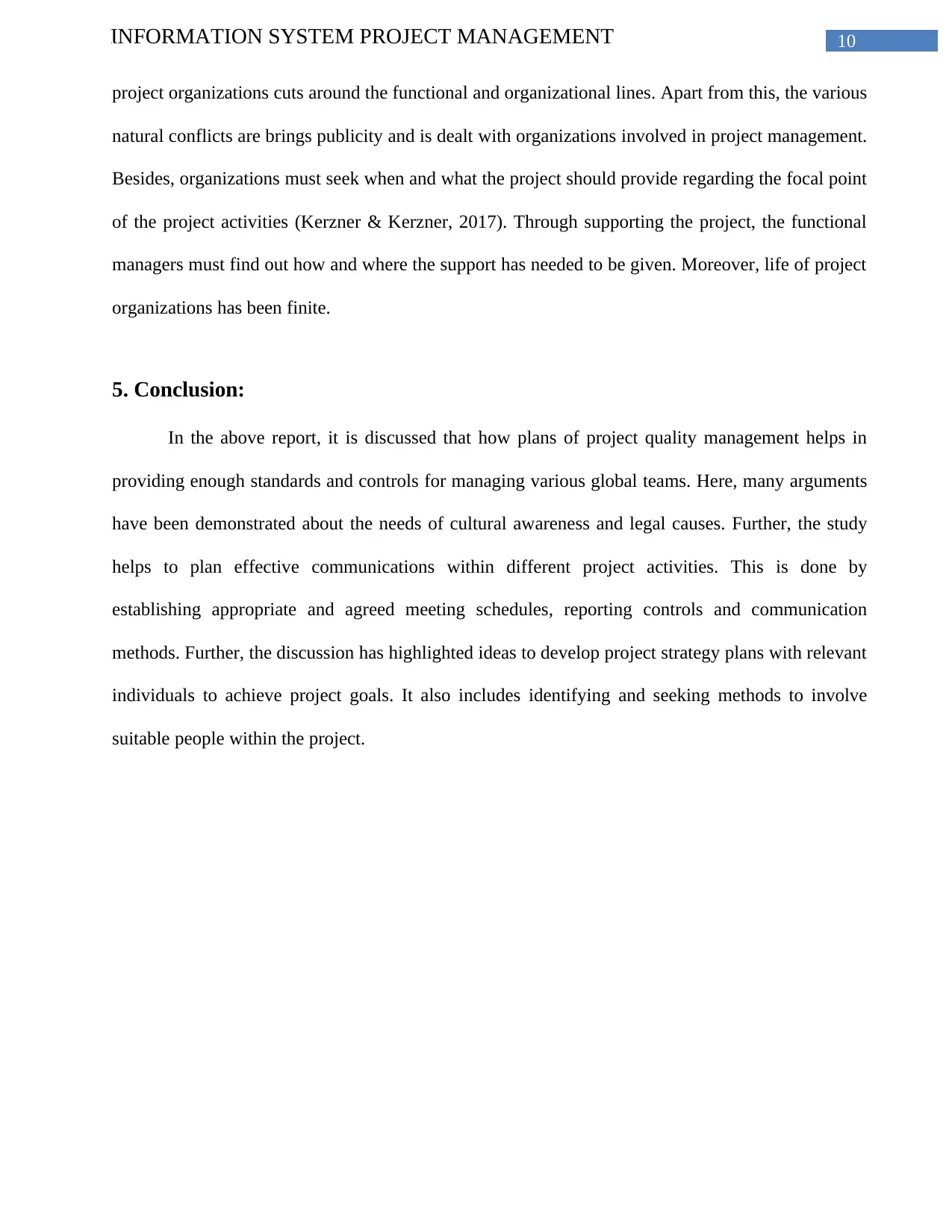
10INFORMATION SYSTEM PROJECT MANAGEMENT
project organizations cuts around the functional and organizational lines. Apart from this, the various
natural conflicts are brings publicity and is dealt with organizations involved in project management.
Besides, organizations must seek when and what the project should provide regarding the focal point
of the project activities (Kerzner & Kerzner, 2017). Through supporting the project, the functional
managers must find out how and where the support has needed to be given. Moreover, life of project
organizations has been finite.
5. Conclusion:
In the above report, it is discussed that how plans of project quality management helps in
providing enough standards and controls for managing various global teams. Here, many arguments
have been demonstrated about the needs of cultural awareness and legal causes. Further, the study
helps to plan effective communications within different project activities. This is done by
establishing appropriate and agreed meeting schedules, reporting controls and communication
methods. Further, the discussion has highlighted ideas to develop project strategy plans with relevant
individuals to achieve project goals. It also includes identifying and seeking methods to involve
suitable people within the project.
project organizations cuts around the functional and organizational lines. Apart from this, the various
natural conflicts are brings publicity and is dealt with organizations involved in project management.
Besides, organizations must seek when and what the project should provide regarding the focal point
of the project activities (Kerzner & Kerzner, 2017). Through supporting the project, the functional
managers must find out how and where the support has needed to be given. Moreover, life of project
organizations has been finite.
5. Conclusion:
In the above report, it is discussed that how plans of project quality management helps in
providing enough standards and controls for managing various global teams. Here, many arguments
have been demonstrated about the needs of cultural awareness and legal causes. Further, the study
helps to plan effective communications within different project activities. This is done by
establishing appropriate and agreed meeting schedules, reporting controls and communication
methods. Further, the discussion has highlighted ideas to develop project strategy plans with relevant
individuals to achieve project goals. It also includes identifying and seeking methods to involve
suitable people within the project.
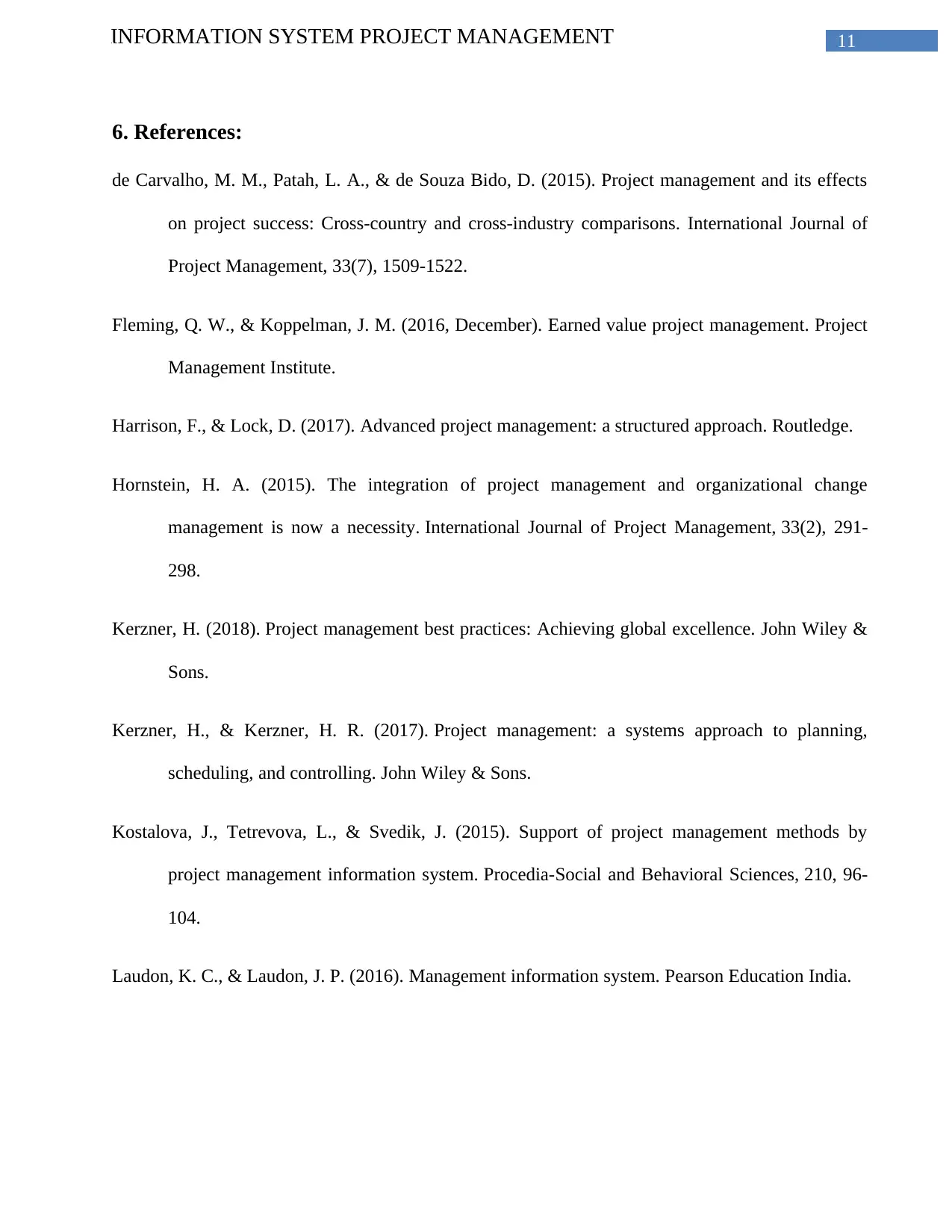
11INFORMATION SYSTEM PROJECT MANAGEMENT
6. References:
de Carvalho, M. M., Patah, L. A., & de Souza Bido, D. (2015). Project management and its effects
on project success: Cross-country and cross-industry comparisons. International Journal of
Project Management, 33(7), 1509-1522.
Fleming, Q. W., & Koppelman, J. M. (2016, December). Earned value project management. Project
Management Institute.
Harrison, F., & Lock, D. (2017). Advanced project management: a structured approach. Routledge.
Hornstein, H. A. (2015). The integration of project management and organizational change
management is now a necessity. International Journal of Project Management, 33(2), 291-
298.
Kerzner, H. (2018). Project management best practices: Achieving global excellence. John Wiley &
Sons.
Kerzner, H., & Kerzner, H. R. (2017). Project management: a systems approach to planning,
scheduling, and controlling. John Wiley & Sons.
Kostalova, J., Tetrevova, L., & Svedik, J. (2015). Support of project management methods by
project management information system. Procedia-Social and Behavioral Sciences, 210, 96-
104.
Laudon, K. C., & Laudon, J. P. (2016). Management information system. Pearson Education India.
6. References:
de Carvalho, M. M., Patah, L. A., & de Souza Bido, D. (2015). Project management and its effects
on project success: Cross-country and cross-industry comparisons. International Journal of
Project Management, 33(7), 1509-1522.
Fleming, Q. W., & Koppelman, J. M. (2016, December). Earned value project management. Project
Management Institute.
Harrison, F., & Lock, D. (2017). Advanced project management: a structured approach. Routledge.
Hornstein, H. A. (2015). The integration of project management and organizational change
management is now a necessity. International Journal of Project Management, 33(2), 291-
298.
Kerzner, H. (2018). Project management best practices: Achieving global excellence. John Wiley &
Sons.
Kerzner, H., & Kerzner, H. R. (2017). Project management: a systems approach to planning,
scheduling, and controlling. John Wiley & Sons.
Kostalova, J., Tetrevova, L., & Svedik, J. (2015). Support of project management methods by
project management information system. Procedia-Social and Behavioral Sciences, 210, 96-
104.
Laudon, K. C., & Laudon, J. P. (2016). Management information system. Pearson Education India.
⊘ This is a preview!⊘
Do you want full access?
Subscribe today to unlock all pages.

Trusted by 1+ million students worldwide
1 out of 14
Related Documents
Your All-in-One AI-Powered Toolkit for Academic Success.
+13062052269
info@desklib.com
Available 24*7 on WhatsApp / Email
![[object Object]](/_next/static/media/star-bottom.7253800d.svg)
Unlock your academic potential
Copyright © 2020–2025 A2Z Services. All Rights Reserved. Developed and managed by ZUCOL.

